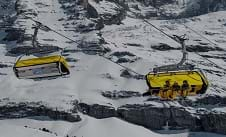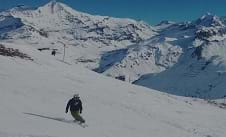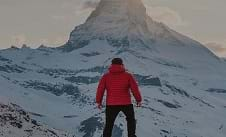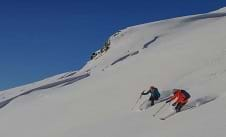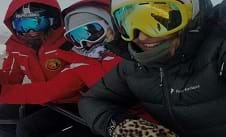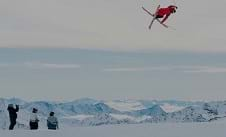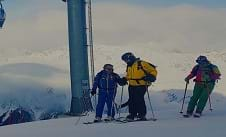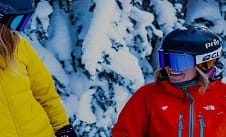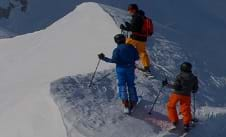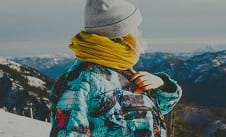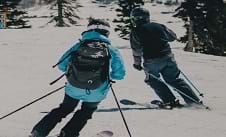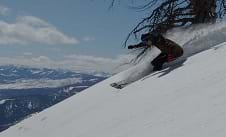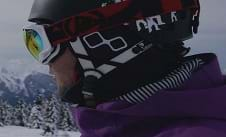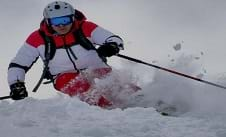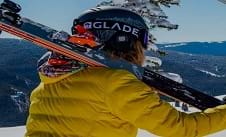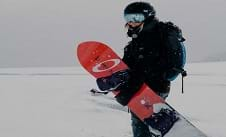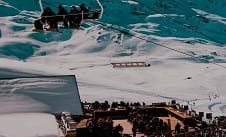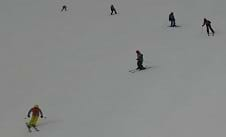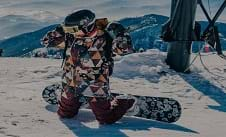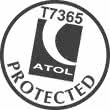Ski & snowboard jackets guide
Deciding on the right ski jacket can be tough. There are several factors to weigh up when purchasing your dream jacket for the slopes, plus an abundance of style choices, from the slim-fit for the neat technical skiers to loose-fit for those freestyle powder hounds.
Your ski jacket should be snug enough to keep you warm without underlayers, but also not too tight, so you can layer up for the colder days and still be able to move. With downhill skiing and snowboarding, you can experience wind chill, so make sure you have a jacket with high windproof functionality, while also ensuring it has good breathability. A ski jacket is designed to keep you insulated and dry, so a waterproof one is essential. Ski jackets also serve as a way for you to express your individual style on the slopes, so if neon colours or retro onesies are your thing, then go for it!
Some key features to look out for when choosing your new investment, are pockets, lift pass holder (usually located in a zipped pocket on the arm of your jacket or on the inner left-hand side), goggle pockets on the inside, and hoods big enough for your helmet. Ventilation is another feature to look out for; zippers under the arms to allow your body to breathe if you get too hot. Many jackets also come with a powder skirt to ensure that if you fall or ski/board in deep powder, you remain dry if snow gets up inside your jacket.
To choose the right jacket for you, think about the type of skiing/boarding you will be doing. Loose-fitting jackets are ideal for freestyle and snowboarders as they offer more mobility. Regular fitted jackets provide the feel of a slim-fit jacket and the freedom of movement and slim fitted jackets, which are great for technical skiers, giving more control over movement.
with your own travel concierge. Don’t hesitate to drop us a line – we’ll
help plan your perfect Ski Holidays.
020 7770 6888 ← online or call ↴
020 7770 6888
Men’s ski & snowboard jackets
Generally, there is not a huge difference between men’s and women’s jackets. Men’s jackets tend to have broader shoulders and backs to accommodate their anatomically different shapes to women. They would usually have longer sleeves too.
Your level of expertise will usually determine what type of jacket you need and how much to spend. Some top brands for men’s jackets are The North Face, Helly Hansen, Patagonia, Jack Wolfskin and Columbia, among many more. These can all be purchased on their direct websites instore, or third-party retail sites and stores such as Sports Direct, Snow + Rock, Ellis Brigham. If you ski several times a year, go to high altitude (colder) resorts or are more sensitive to cold temperatures you may want to invest in a more expensive jacket with better insulating, better waterproofing and features like vents and a snow skirt.
Women’s ski & snowboard jackets
There is an abundance of style choice for women’s jackets, with most having a cinched in waist and more generously cut on the hips than men’s jacket. Women’s ski jackets have the same features as men’s jackets, such as a multitude of pockets, powder skirt and ventilation zips. An insulated jacket is the best option if you are sensitive to colder temperatures. Read our insultation section below for features to look out for.
Some great premium brands for women’s ski jackets include The North Face, Spyder, Helly Hansen and Black Diamond. There is a brand called Nikita that caters solely for females and are sold at Alpine Trek, Ellis Brigham and Absolute Snow. You can find a good selection of great-value ski jackets at Mountain Warehouse, Trespass and TK Maxx – these jackets are perfectly fine for beginners and if you plan to ski just once a year.
Girls ski jacket
When it comes to children’s ski jackets, the focus is more on keeping them warm and dry, rather than the endless technical features incorporated on adult jackets. The main elements to look for in a girl’s ski jacket are the warmth, waterproofing and breathability. 3-in-1 jackets are great for kids and are more economical, as they are comprised of an inner shell for insulation and an outer shell to protect against wind/weather. These jackets can be worn as one with the inner and outer shell, or they can be worn separately. The outer shell is great for skiing in the warmer weather in spring and the inner shell can be worn casually.
Girls’ ski jackets come in a variety of colours and patterns, so your little princess will look effortlessly chic on the slopes. Among the top ski brands for girls are The North Face, Roxy, Animal, O’Neil, Trespass and Mountain Warehouse.
Boy’s ski jacket
Similar to girls’ ski jackets, boys’ ski jackets are designed to be practical and warm, with the key features being waterproofing, breathability and warmth. The main difference from the girls’ jackets will be the style and colours. There is even a dinosaur themed coat for boys from Dinoski Spike. One-piece suits are a popular choice for younger children as they provide warmth. However, they aren’t entirely practical when it comes to needing to go to the bathroom! There are some great matching ski trousers and jackets on the market for kids, and some popular brands for boys are Quiksilver, Columbia, Dare2b, O’Neil and Mountain Warehouse.
Key features of a ski jacket
Ski jacket insulation
For extra warmth opt for a ski jacket with an insulated layer, which is generally made of fleece, down or a synthetic fabric. Some jackets may even have an additional layer of insulation that can be removed, these can be referred to as 3-in-1 jackets. Look out for the grams of insulation when browsing jackets – the greater the number the warmer it will be. Numbers can be as low as 30 for minimal insultation and as high as 800 grams for down fabric.
Ski jacket waterproof rating
Waterproof ratings are a significant factor when choosing a ski jacket as you need to be protected from snow and rain. Ratings will tell you how quickly your ski jacket will become soaked and risk the rest of your layers becoming wet. Waterproof ratings are measured in millimetres, and the higher the number, the more waterproof the jacket will be. Jackets need a minimum 1500 mm rating to be classed as waterproof. The average ski jacket will have a rating between 5000 – 10, 000 mm and can go as high as 30, 000 mm. Ski jackets with higher ratings will also be more expensive.
Ski jacket FAQ:
In general terms, it should be waterproof, windproof and hard-wearing.
Useful features to look out for:
- Waterproof rating - Usually measured in thousands of mm. A higher number is more waterproof.
- Breathable - Waterproof is great, but for the comfort, you’ll want it to be breathable too. This is rating measured in thousands of grams.
- Taped seams - Another waterproofing element
- Ventilation - Zipped areas (underarm) for when you’re overheating. There is usually meshing to keep snow out.
- Cuffs, skirts and collars - Long cuffs that go into your gloves keep your wrist covered where they meet the glove. A snow skirt keeps the snow out if (when) you fall and some companies have integrated systems with their ski trousers. A high collar that you can pull up on lifts and low temps is great for protecting the lower part of the face and neck.
- The hood - Most wear helmets nowadays so can your hood fit over a helmet? Will you want to?
- Lift pass pocket - Seems minor but fishing a lift pass out at every lift is miserable. Some jackets have an arm pocket (left forearm is popular) as most lifts use electronic/RFID systems, so all you have to do is wave.
- Fit- Slim/fitted, regular or loose. This will depend on your preference and riding. For example, a freestyle skier won’t want something that restricts movement.
- Layers - What do you want to wear under the jacket.
- Colour - There are SO many options available for colour, but you can’t go wrong being nice and visible on the slopes.
Things to consider:
You don’t need a ski jacket to ski, but it is highly recommended. A poorly suited jacket can not only hamper your movement and ability to ski, but it can also make you miserably cold.
Carefully! Always check the manufacturer's instructions, or you can make an expensive mistake. Some may require treatments to maintain or renew waterproof qualities. You can buy technical cleaner for waterproof materials - try Nikwax Tech Wash.
Ultimately, you're paying for technology (materials), construction and quality. Features on expensive jackets will not be present on entry-level models, so work out what most important to you. For everyone, there's a balance between cost and requirements, and the equipment market will have something for everyone.
It's important to mention that taking advantage of the end of season sales and places like Decathlon can cut these costs substantially and try to avoid buying in resort as you'll pay a premium. Find out where to buy cheap ski clothes.
You can, but down jackets retain heat poorly when wet. Bear in mind this isn't just the snow trying to get in but also from sweat on the inside, so they don't function well as outer or mid-layers.
The average outdoor down/puffer jacket isn't designed for a ski fall either, so one trip and you could be looking for a replacement. We'd recommend getting a specialised ski jacket.
Short answer: Yes. Longer answer: The biggest difference between ski and snowboard jackets is fit, a concession to the different movements each discipline requires. In general, a snowboard jacket will offer a looser, less aerodynamic fit than a ski jacket and will be longer, or at least have a longer back as a concession to time spent sitting on the snow (doing bindings up, etc.)
Most people will take one and use the same jacket throughout a week's trip, drying it overnight. If you have space and want to rotate two, there's no reason not to, especially if you intend to do something specialised like deep powder skiing or park skiing one day where you'll benefit from a different fit.
Fit comes down to preference and what you'll be doing on the slopes. A tighter jacket may help with warmth, but too tight and movement can be restricted. You might find it harder to layer up under a tight-fitting jacket too. Conversely, too loose and heat can seep out and, snow in when you fall. Ski jackets tend to gravitate to a snug fit for better aerodynamics, so often aren't suitable for snowboarders or park skiers that need more freedom of movement.
Simply put, the clue is in the name. A ski (or snowboard - there are differences) jacket will be optimised to its purpose. The fit will be focused on the discipline with elements like length (for skiing, hip length), insulation material, ventilation and mobility all augment your riding style.
Your average winter jacket will be focused on insulation, often at the cost of freedom of movement and weight, with little thought to things like snow skirts or helmet covering hoods.
The more technical winter jackets may be lighter (due to construction/materials) and more performance-focused (snug fits, better movement, helmet covering hoods) but not on a ski/snowboard movement, again making them a poor choice.
Short answer: Snowsports jackets are made with the skier/snowboarder in mind, casual or technical winter jackets are not.
Layers are worn under a ski jacket. It's better to have extra clothes and not need them than to need them and not have them. You might be warm with just a t-shirt and jacket at 1500m, but you won't be at 3000m.
Tinker with what works best for you but here's a start point:
- A base layer- Usually long-sleeved and wicking
- A secondary layer- Technical t-shirt of equivalent
- A mid-layer- A lightweight fleece or jumper
Add or remove layers based on how much you feel the cold until you're comfortable.






